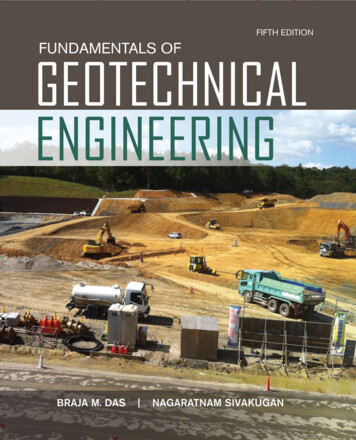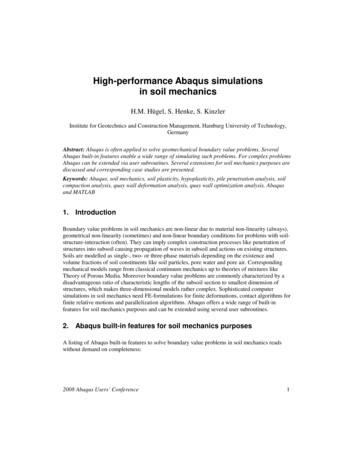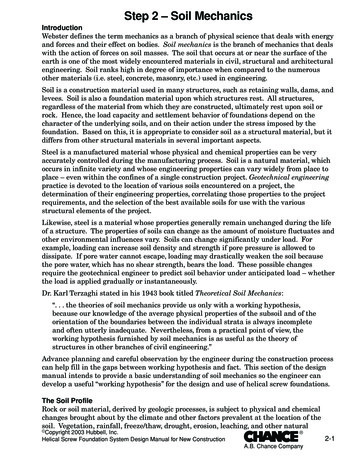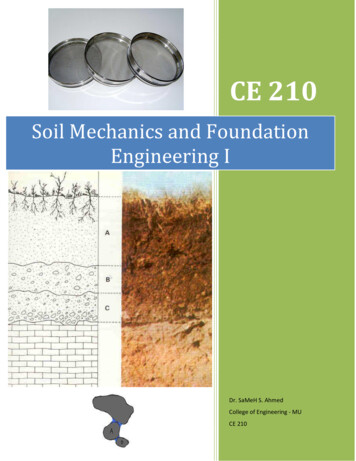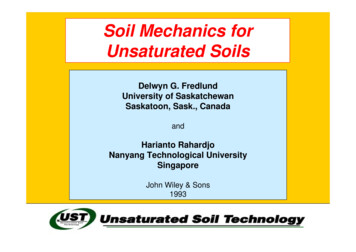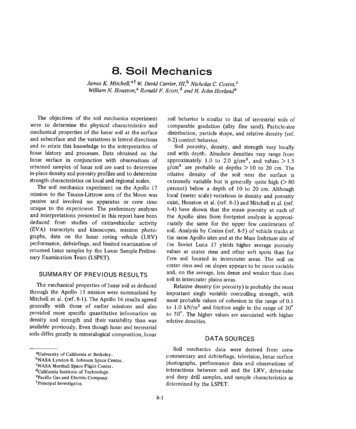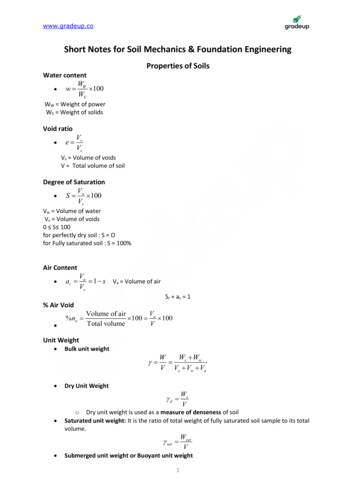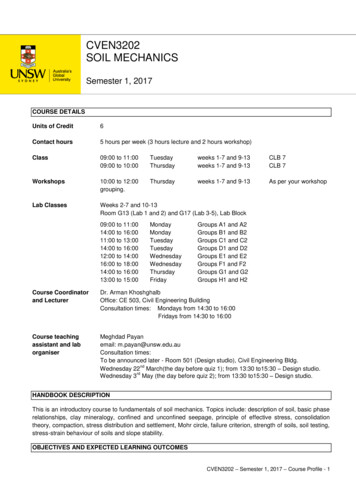
Transcription
CVEN3202SOIL MECHANICSSemester 1, 2017COURSE DETAILSUnits of Credit6Contact hours5 hours per week (3 hours lecture and 2 hours workshop)Class09:00 to 11:0009:00 to 10:00TuesdayThursdayweeks 1-7 and 9-13weeks 1-7 and 9-13CLB 7CLB 7Workshops10:00 to 12:00grouping.Thursdayweeks 1-7 and 9-13As per your workshopLab ClassesWeeks 2-7 and 10-13Room G13 (Lab 1 and 2) and G17 (Lab 3-5), Lab Block09:00 to 11:0014:00 to 16:0011:00 to 13:0014:00 to 16:0012:00 to 14:0016:00 to 18:0014:00 to 16:0013:00 to hursdayFridayGroups A1 and A2Groups B1 and B2Groups C1 and C2Groups D1 and D2Groups E1 and E2Groups F1 and F2Groups G1 and G2Groups H1 and H2Course Coordinatorand LecturerDr. Arman KhoshghalbOffice: CE 503, Civil Engineering BuildingConsultation times: Mondays from 14:30 to 16:00Fridays from 14:30 to 16:00Course teachingassistant and laborganiserMeghdad Payanemail: m.payan@unsw.edu.auConsultation times:To be announced later - Room 501 (Design studio), Civil Engineering Bldg.ndWednesday 22 March(the day before quiz 1); from 13:30 to15:30 – Design studio.rdWednesday 3 May (the day before quiz 2); from 13:30 to15:30 – Design studio.HANDBOOK DESCRIPTIONThis is an introductory course to fundamentals of soil mechanics. Topics include: description of soil, basic phaserelationships, clay mineralogy, confined and unconfined seepage, principle of effective stress, consolidationtheory, compaction, stress distribution and settlement, Mohr circle, failure criterion, strength of soils, soil testing,stress-strain behaviour of soils and slope stability.OBJECTIVES AND EXPECTED LEARNING OUTCOMESCVEN3202 – Semester 1, 2017 – Course Profile - 1
The objective of the course is to understand the basic principles of soil mechanics and to study the behaviour ofsoil as an engineering material, both theoretically (through lectures) and practically (through laboratory classes).By the end of the course successful students should: understand the fundamentals of the behaviour of soil as an engineering material, relate to those aspects of soil behaviour which have a significant environmental impact, be able to solve a range of soil related problems especially those involving water flow, soil settlementand soil strength, have a sound basis for further formal study and self-study in the geotechnical area, be developing a rational approach to problem solving which will lead to the development of design skills.TEACHING STRATEGIESThe contents of this subject will be presented in a series of lectures followed by workshops. The lectures explainthe theory of soil behaviour and greatly assist in understanding the different concepts in classical soilmechanics. Understanding and application of each concept will be enhanced in workshops.In order to understand different soil mechanics topics well, it is essential for students to attend the workshopsand solve the workshop problems by themselves. It is expected that students will put in at least 1.5 hours ofprivate study for each hour of contact. During private studies students should review and reflect on lecturematerial and class problems, solve workshop problems, and generally study the concepts taught in a soilmechanics book.An example of the approaches to learning is:LecturesWorkshopsPrivate Study Find out what you must learnFollow worked examplesObserve solution methodsBe guided by demonstratorPractice solving workshop questionsAsk questionsReview lecture material and textbookSolve workshop questionsReflect on class problems and workshop questionsRELEVANT RESOURCESThe textbook for the course, on which most of the course PowerPoint slides are based and contains thoroughexplanations and dozens of worked examples, is sold in the UNSW bookshop:Holtz, R.D., Kovacs, W.D. and Sheahan, T.C. (2011), “An Introduction to Geotechnical Engineering”, SecondEdition. International Edition. Pearson.The following reference books may also be useful for additional reading, many of them can be found in theUNSW library: Craig, R. F. "Soil Mechanics", CRC press, 2012Das, B. M., “Principles of Geotechnical Engineering”, PWS publishing, 1998-2006Lambe and Whitman, "Soil Mechanics", Wiley, 1975Scott, C., "An Introduction to Soil Mechanics and Foundation Engineering", AS Publisher, 1980Budhu, M., “Soil Mechanics and Foundations”, Wiley & Sons, 2007Smith, I, “Smith’s Element of Soil Mechanics”, Blackwell, 2006Also, students may find the following Soil Mechanics Book in PDF in a table under the “software” section” 012.pdfCVEN3202 – Semester 1, 2017 – Course Profile - 2
ASSESSMENTAssessment will be based on laboratory works, two quizzes during the semester and a final exam, as follows:ItemMarksDateAssessment CriteriaLaboratoryworks10%One weekaftercompletion ofeach lab classLaboratory work is an important part of this course. After each labclass, you should prepare a lab report. Each report should contain youroriginal worksheets from the laboratory, data, calculations, graphs andanswers to questions found at the end of each laboratory description inthe lab manual. Refer to your laboratory manual for more details.Quiz 115%Week 4Quiz 215%Week 9Final Exam60%Exam periodThe quizzes will be assessed on the basis of technical accuracy ofcalculations and evidence of understanding the main concepts taughtin the course.The quizzes are closed book; however, required formulas and/orcharts will be provided.The final exam will cover the entire course. It will be assessed againstthe learning outcomes of the course.The final exam is closed book; however, a formula sheet includingnecessary formulas and charts will be provided. A sample formulasheet will be uploaded to Moodle before the final exam.Note:1. There are five laboratory classes. Reports on these are due one week after completion of each class. Eachreport is marked out of 10 marks and a penalty of 1 mark per each day of late submission will be applied.2. No marks will be awarded for reports that are between 10 to 30 days late.3. 5 marks deduction (from the final mark) will be applied for any report which is missing or more than 30 dayslate. Reports submitted without attending the corresponding lab class are considered as missing.4. The reports shall be deposited in the boxes outside Room 210 (in front of Room 207).5. Each laboratory class has a limited capacity; you are required to attend your allocated class.6. The exam scripts will not be returned.7. In order to pass the subject, students must receive 30% or more in the final examination and receive anoverall total of 50% marks or more for the subject.COURSE PROGRAMWeek 1:Introduction, phase relationshipNo LaboratoryWorkshop 1Week 2:Classification of soils, Clay mineralogyLaboratory 1 - Groups A1, B1, C1, D1, E1, F1, G1, H1Workshop 2Week 3:Compaction, Stress and Mohr circleLaboratory 1 - Groups A2, B2, C2, D2, E2, F2, G2, H2Workshop 3Week 4:Stress in soils, Effective stress concept, Stress distributionLaboratory 2 - Groups A1, B1, C1, D1, E1, F1, G1, H1Workshop 4 - Quiz 1 (weeks 1-3)CVEN3202 – Semester 1, 2017 – Course Profile - 3
Week 5:One-dimensional seepage, Darcy's lawLaboratory 2 - Groups A2, B2, C2, D2, E2, F2, G2, H2Workshop 5Week 6:Two-dimensional seepage, Flow netsLaboratory 3 - Groups A1, B1, C1, D1, E1, F1, G1, H1Workshop 6Week 7:Consolidation theory, One-dimensional settlement of soil deposits, Rate of consolidationLaboratory 3 - Groups A2, B2, C2, D2, E2, F2, G2, H2Workshop 7Semester breakWeek 8:No LectureNo LaboratoryNo WorkshopWeek 9:Shear strength of soils, Mohr Coulomb failure criterion, Direct shear testNo LaboratoryWorkshop 8 - Quiz 2 (weeks 4-7)Week 10: Solving quiz questions and class examplesLaboratory 4 - Groups A1, B1, C1, D1, E1, F1, G1, H1Workshop 9Week 11: Shear strength of soils (cont.), Triaxial test, Pore pressure parametersLaboratory 4 - Groups A2, B2, C2, D2, E2, F2, G2, H2Workshop 10Week 12: Stress path techniqueLaboratory 5 - Groups A1, B1, C1, D1, E1, F1, G1, H1Workshop 11Week 13: Slope stability, infinite slopes, Methods of slices, Taylor’s slope stability chartsLaboratory 5 - Groups A2, B2, C2, D2, E2, F2, G2, H2Workshop 12SCHEDULE OF LABORATORY CLASSESWeek2DayLaboratory 1Monday, 09:00 to 11:00Group A1Monday, 14:00 to 16:00Group B1Tuesday, 11:00 to 13:00Group C1Tuesday, 14:00 to 16:00Group D1Wednesday, 12:00 to 14:00Group E1Wednesday, 16:00 to 18:00Group F1Thursday, 14:00 to 16:00Group G1Friday, 13:00 to 15:00Group H1Laboratory 2Laboratory 3Laboratory 4Laboratory 5CVEN3202 – Semester 1, 2017 – Course Profile - 4
3456710Monday, 09:00 to 11:00Group A2Monday, 14:00 to 16:00Group B2Tuesday, 11:00 to 13:00Group C2Tuesday, 14:00 to 16:00Group D2Wednesday, 12:00 to 14:00Group E2Wednesday, 16:00 to 18:00Group F2Thursday, 14:00 to 16:00Group G2Friday, 13:00 to 15:00Group H2Monday, 09:00 to 11:00Group A1Monday, 14:00 to 16:00Group B1Tuesday, 11:00 to 13:00Group C1Tuesday, 14:00 to 16:00Group D1Wednesday, 12:00 to 14:00Group E1Wednesday, 16:00 to 18:00Group F1Thursday, 14:00 to 16:00Group G1Friday, 13:00 to 15:00Group H1Monday, 09:00 to 11:00Group A2Monday, 14:00 to 16:00Group B2Tuesday, 11:00 to 13:00Group C2Tuesday, 14:00 to 16:00Group D2Wednesday, 12:00 to 14:00Group E2Wednesday, 16:00 to 18:00Group F2Thursday, 14:00 to 16:00Group G2Friday, 13:00 to 15:00Group H2Monday, 09:00 to 11:00Group A1Monday, 14:00 to 16:00Group B1Tuesday, 11:00 to 13:00Group C1Tuesday, 14:00 to 16:00Group D1Wednesday, 12:00 to 14:00Group E1Wednesday, 16:00 to 18:00Group F1Thursday, 14:00 to 16:00Group G1Friday, 13:00 to 15:00Group H1Monday, 09:00 to 11:00Group A2Monday, 14:00 to 16:00Group B2Tuesday, 11:00 to 13:00Group C2Tuesday, 14:00 to 16:00Group D2Wednesday, 12:00 to 14:00Group E2Wednesday, 16:00 to 18:00Group F2Thursday, 14:00 to 16:00Group G2Friday, 13:00 to 15:00Public holidayMonday, 09:00 to 11:00Group A1Monday, 14:00 to 16:00Group B1Tuesday, 11:00 to 13:00Group C1Tuesday, 14:00 to 16:00Group D1Wednesday, 12:00 to 14:00Group E1CVEN3202 – Semester 1, 2017 – Course Profile - 5
111213Wednesday, 16:00 to 18:00Group F1Thursday, 14:00 to 16:00Group G1Friday, 13:00 to 15:00Group H1Monday, 09:00 to 11:00Group A2Monday, 14:00 to 16:00Group B2Tuesday, 11:00 to 13:00Group C2Tuesday, 14:00 to 16:00Group D2Wednesday, 12:00 to 14:00Group E2Wednesday, 16:00 to 18:00Group F2Thursday, 14:00 to 16:00Group G2Friday, 13:00 to 15:00Group H2Monday, 09:00 to 11:00Group A1Monday, 14:00 to 16:00Group B1Tuesday, 11:00 to 13:00Group C1Tuesday, 14:00 to 16:00Group D1Wednesday, 12:00 to 14:00Group E1Wednesday, 16:00 to 18:00Group F1Thursday, 14:00 to 16:00Group G1Friday, 13:00 to 15:00Group H1Monday, 09:00 to 11:00Group A2Monday, 14:00 to 16:00Group B2Tuesday, 11:00 to 13:00Group C2Tuesday, 14:00 to 16:00Group D2Wednesday, 12:00 to 14:00Group E2Wednesday, 16:00 to 18:00Group F2Thursday, 14:00 to 16:00Group G2Friday, 13:00 to 15:00Group H2DATES TO NOTERefer to MyUNSW for Important Dates available es.htmlPLAGIARISMBeware! An assignment that includes plagiarised material will receive a 0% Fail, and students who plagiarisemay fail the course. Students who plagiarise are also liable to disciplinary action, including exclusion fromenrolment.Plagiarism is the use of another person’s work or ideas as if they were your own. When it is necessary ordesirable to use other people’s material you should adequately acknowledge whose words or ideas they are andwhere you found them (giving the complete reference details, including page number(s)). The Learning Centreprovides further information on what constitutes Plagiarism at:https://student.unsw.edu.au/plagiarismACADEMIC ADVICEFor information about: Notes on assessments and plagiarism, School policy on Supplementary exams, Special Considerations,CVEN3202 – Semester 1, 2017 – Course Profile - 6
Solutions to Problems, Year Managers and Grievance Officer of Teaching and Learning Committee, and CEVSOC.Refer to Academic Advice on the School website available ering/resources/academic-adviceCVEN3202 – Semester 1, 2017 – Course Profile - 7
"An Introduction to Soil Mechanics and Foundation Engineering", AS Publisher, 1980 Budhu, M., "Soil Mechanics and Foundations", Wiley & Sons, 2007 Smith, I, "Smith's Element of Soil Mechanics", Blackwell, 2006 Also, students may find the following Soil Mechanics Book in PDF in a table under the "software" section" from




